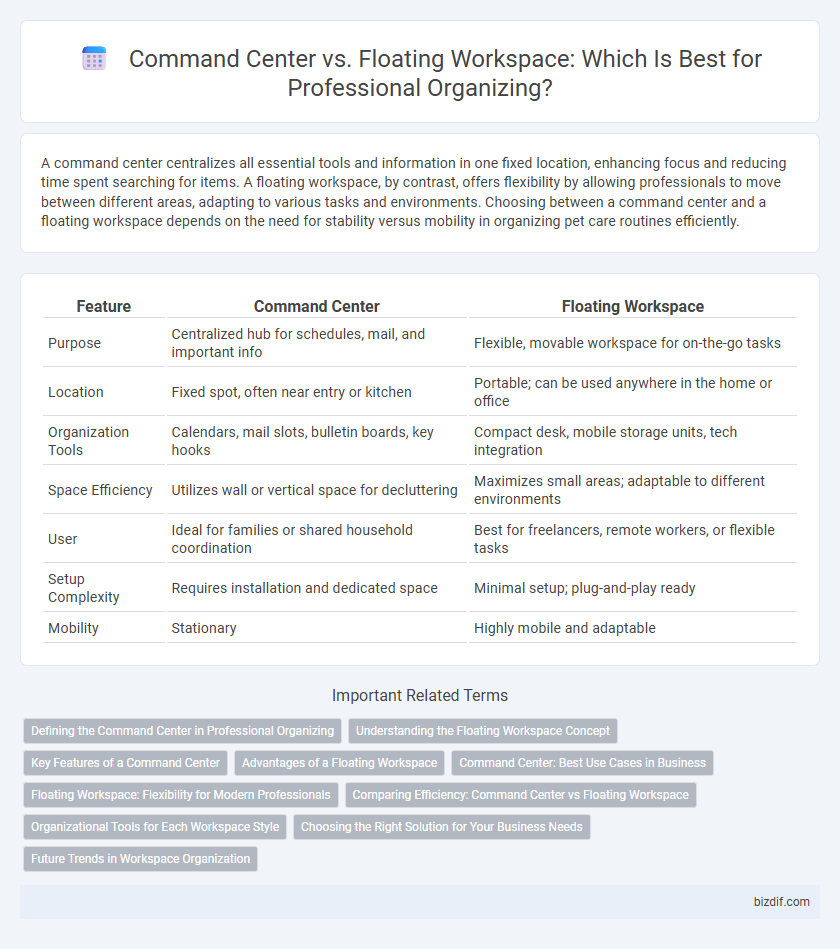A command center centralizes all essential tools and information in one fixed location, enhancing focus and reducing time spent searching for items. A floating workspace, by contrast, offers flexibility by allowing professionals to move between different areas, adapting to various tasks and environments. Choosing between a command center and a floating workspace depends on the need for stability versus mobility in organizing pet care routines efficiently.
Table of Comparison
| Feature | Command Center | Floating Workspace |
|---|---|---|
| Purpose | Centralized hub for schedules, mail, and important info | Flexible, movable workspace for on-the-go tasks |
| Location | Fixed spot, often near entry or kitchen | Portable; can be used anywhere in the home or office |
| Organization Tools | Calendars, mail slots, bulletin boards, key hooks | Compact desk, mobile storage units, tech integration |
| Space Efficiency | Utilizes wall or vertical space for decluttering | Maximizes small areas; adaptable to different environments |
| User | Ideal for families or shared household coordination | Best for freelancers, remote workers, or flexible tasks |
| Setup Complexity | Requires installation and dedicated space | Minimal setup; plug-and-play ready |
| Mobility | Stationary | Highly mobile and adaptable |
Defining the Command Center in Professional Organizing
A command center in professional organizing is a centralized hub designed to streamline daily activities, featuring designated spaces for calendars, mail, keys, and essential documents to enhance efficiency and reduce clutter. Unlike a floating workspace, which is flexible and can be moved or adapted throughout the home or office, a command center remains fixed in one location for consistent organization and easy access. This dedicated area supports task management by consolidating important information and tools in a highly visible, accessible spot.
Understanding the Floating Workspace Concept
A floating workspace is a flexible, mobile area designed for temporary tasks, contrasting with a fixed command center that centralizes essential tools and schedules. This concept emphasizes adaptability, allowing users to customize their work environment as needed while maintaining organization and efficiency. Floating workspaces maximize productivity by minimizing clutter and promoting seamless transitions between different activities.
Key Features of a Command Center
A command center in professional organizing features a centralized hub designed to streamline daily activities with designated zones for calendars, mail sorting, and essential supplies. It incorporates wall-mounted organizers, whiteboards, and charging stations to enhance productivity and minimize clutter. Unlike a floating workspace, a command center provides a fixed, highly functional area that fosters efficient time management and task coordination.
Advantages of a Floating Workspace
A floating workspace offers flexibility by allowing users to easily reposition their work area according to changing needs and room layouts, enhancing adaptability in professional organizing. It promotes efficient use of space in small or multi-functional environments by eliminating the need for a fixed desk, facilitating seamless workflow transitions. This mobility supports dynamic organization systems, enabling quick access to supplies and documents wherever they are most needed.
Command Center: Best Use Cases in Business
A command center in business offers a centralized hub for managing operations, improving communication, and enhancing productivity by consolidating essential tools and information in one accessible location. Ideal for project management, daily performance tracking, and team coordination, it streamlines workflows by reducing distractions and optimizing task prioritization. Unlike a floating workspace, the command center provides a fixed, highly organized environment that supports consistent execution of complex business processes.
Floating Workspace: Flexibility for Modern Professionals
A floating workspace offers unparalleled flexibility for modern professionals by allowing seamless transitions between different tasks and locations without the constraints of a fixed setup. Incorporating modular furniture, compact storage solutions, and mobile technology, floating workspaces enhance productivity and adapt to evolving workflows. This dynamic arrangement suits remote work, hot-desking, and collaborative environments, prioritizing efficiency and organization in professional settings.
Comparing Efficiency: Command Center vs Floating Workspace
A command center offers centralized organization with designated spaces for calendars, mail, and essential items, enhancing daily workflow efficiency through consistent accessibility. In contrast, a floating workspace provides flexibility by allowing tools and materials to move with the user, supporting dynamic tasks and varied work locations. Choosing between the two depends on prioritizing structured routine versus adaptable mobility for optimal productivity.
Organizational Tools for Each Workspace Style
Command centers utilize wall-mounted calendars, labeled bins, and message boards to consolidate schedules and essential documents, optimizing centralized organization. Floating workspaces rely on portable organizers, modular trays, and digital apps to maintain flexibility and accommodate varied locations. Each workspace style benefits from tailored organizational tools designed to enhance productivity and reduce clutter.
Choosing the Right Solution for Your Business Needs
A command center centralizes task management, schedules, and communication tools to streamline workflow and increase productivity. In contrast, a floating workspace offers flexibility and mobility, enabling employees to work from various locations within the office or remotely. Selecting between a command center and a floating workspace depends on your business size, operational style, and the need for collaboration versus individual focus.
Future Trends in Workspace Organization
Command centers offer centralized control and efficient task management, making them a staple in modern workspace organization, while floating workspaces provide flexibility and adaptability for dynamic work environments. Emerging trends emphasize integration of smart technology and modular designs, enhancing productivity and personalized workflow customization. The future of workspace organization increasingly prioritizes hybrid solutions combining command center stability with floating workspace mobility to address evolving professional demands.
command center vs floating workspace Infographic

 bizdif.com
bizdif.com